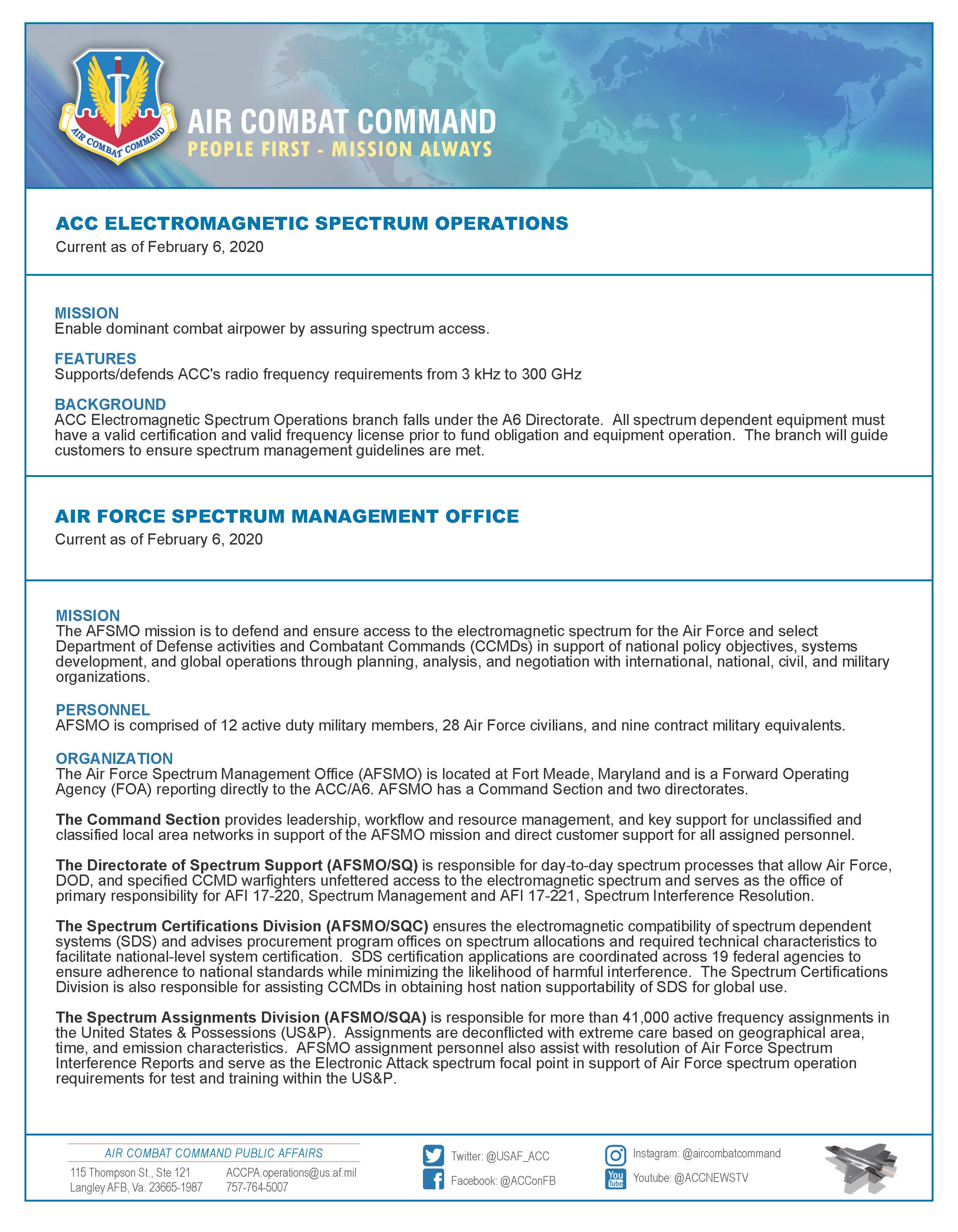Current as of February 6, 2020
The Air Force Spectrum Management Office (AFSMO) is located at Fort Meade, Maryland and is a Forward Operating Agency (FOA) reporting directly to the ACC/A6.
Mission
The AFSMO mission is to defend and ensure access to the electromagnetic spectrum for the Air Force and select Department of Defense activities and Combatant Commands (CCMDs) in support of national policy objectives, systems development, and global operations through planning, analysis, and negotiation with international, national, civil, and military organizations.
Personnel
AFSMO is comprised of 12 active duty military members, 28 Air Force civilians, and 9 contract military equivalents.
Organization
AFSMO has a Command Section and two directorates.
The Command Section provides leadership, workflow and resource management, and key support for unclassified and classified local area networks in support of the AFSMO mission and direct customer support for all assigned personnel.
The Directorate of Spectrum Support (AFSMO/SQ) is responsible for day-to-day spectrum processes that allow Air Force, DOD, and specified CCMD warfighters unfettered access to the electromagnetic spectrum and serves as the office of primary responsibility for AFI 17-220, Spectrum Management and AFI 17-221, Spectrum Interference Resolution.
The Spectrum Certifications Division (AFSMO/SQC) ensures the electromagnetic compatibility of spectrum dependent systems (SDS) and advises procurement program offices on spectrum allocations and required technical characteristics to facilitate national-level system certification. SDS certification applications are coordinated across 19 federal agencies to ensure adherence to national standards while minimizing the likelihood of harmful interference. The Spectrum Certifications Division is also responsible for assisting CCMDs in obtaining host nation supportability of SDS for global use.
The Spectrum Assignments Division (AFSMO/SQA) is responsible for more than 41,000 active frequency assignments in the United States & Possessions (US&P). Assignments are deconflicted with extreme care based on geographical area, time, and emission characteristics. AFSMO assignment personnel also assist with resolution of Air Force Spectrum Interference Reports and serve as the Electronic Attack spectrum focal point in support of Air Force spectrum operation requirements for test and training within the US&P.
The Directorate of Strategic Spectrum Plans (AFSMO/SM) is the Air Force voice at international, national, civil and military (NATO, allied, and coalition) electromagnetic spectrum forums and is responsible for the development of integrated spectrum plans and long-term strategies addressing current and future Air Force spectrum access requirements.
The National and Warfighting Division (AFSMO/SMN) is responsible for ensuring all national strategic documents and proposals addressing spectrum allocation contain appropriate language to support and protect Air Force national operations. This division assertively prepares the Air Force to respond to national spectrum management issues and propose actions to enhance and preserve national spectrum access and spectrum management strategies within the purview of the Air Force and the DoD. The members of this team collaborate with other federal agencies and integrate Air Force capabilities, supporting spectrum operations now and into the future.
Additionally, the Division is responsible for reviewing all defense and allied strategic spectrum policy documents to enable Air Force spectrum access in DoD and Joint forums. The division participates in critical strategic working groups developing and shaping Air Force future capabilities ensuring spectrum requirements are addressed. The division also collaborates with defense and allied forums to integrate Air Force capabilities in the development of information technology applications and net-centric automated spectrum management tools.
The International and Space Division (AFSMO/SMI) develops, coordinates, formulates and articulates Air Force radio frequency spectrum positions, interests, and proposals on United Nations International Telecommunications Union (ITU) World Radiocommunication Conferences Agenda Items at various military, joint, national, regional and international committees that conduct electromagnetic compatibility (EMC) studies and formulate policy and radio regulations. The Division is responsible for ensuring proper registration, coordination of orbital positions and frequency use for global Air Force satellite systems. This division reviews the National Security Space Strategy and National Security Space Plan and provides recommendations for the integration of spectrum supportability and insertion of spectrum-efficient technologies into Air Force space-based acquisition policy and procedures. This division reviews technical characteristics of planned domestic and foreign satellite systems to ensure system compliance with radio frequency spectrum standards published by the National Telecommunications and Information Administration and ITU. This division coordinates satellite actions internationally and participate in bilateral discussions and negotiations with foreign nations to resolve technical proposals and electromagnetic compatibility issues. The division also represents as the DoD focal point for the DoD/NASA/DOC Pre-Coordination Working Group regarding space launch use of S-band frequency at government launch sites in the US&P and spectrum requirement for new space programs.
History
Due to the rapid proliferation of radio frequency spectrum use from 1906 to 1927, President Calvin Coolidge signed an Executive Order to create the Interagency Radio Advisory Committee or IRAC to assume responsibility of radio frequency assignments to government agencies.
The National Telecommunications Act of 1934 added the Army Air Corps to the IRAC where it assumed a prominent role. During World War II, frequency management was an advisor to the Air Staff and remained that way until 1981 when it became an extended arm of the Air Staff and was named the Frequency Management Center (FMC). From November 1979 to May 1993, the FMC was part of Air Force Communications Command, however, in October 1991 the FMC was renamed to the Air Force Frequency Management Agency (AFFMA). On 4 May 2009, Air Force Space Command gained oversight of AFFMA and on 15 September 2010, AFFMA became the Air Force Spectrum Management Office (AFSMO). On August 1, 2011 AFSMO relocated to the DISA Headquarters building on Fort Meade, Maryland. On 17 July 2018, AFSMO was realigned under Air Combat Command as a FOA, administratively attached to the ACC/A6.
Point of Contact
Air Force Spectrum Management Office
6910 Cooper Avenue
Fort George G. Meade, MD 20755-7088
DSN 375-3743 or Commercial 301-225-3743
E-mail: afsmoccworkflow@us.af.mil